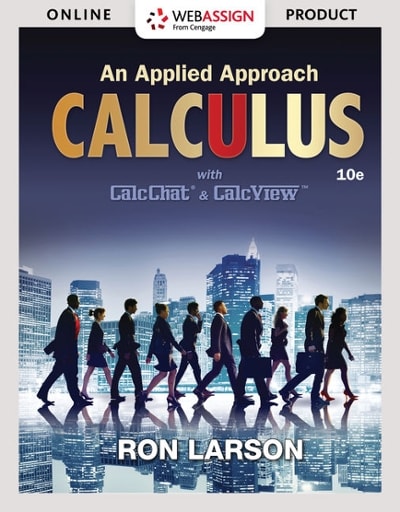Question
1.hexadecimal We usually write numbers in decimal form (or base 10), meaning numbers are composed using 10 different digits{0,1,...,9}.Sometimes though it is useful to write
1.hexadecimal We usually write numbers in decimal form (or base 10), meaning numbers are composed using 10 different "digits"{0,1,...,9}.Sometimes though it is useful to write numbers hexadecimal or base 16. Now there are 16 distinct digits that can be used to form numbers:{0,1,...,9,A,B,C,D,E,F}.So for example, a 3 digit hexadecimal number might be 2B8.
How many 2-digit hexadecimals are there in which the first digit is E or F? Explain your answer in terms of the additive principle (using either events or sets).
Explain why your answer to the previous part is correct in terms of the multiplicative principle (using either events or sets). Why do both the additive and multiplicative principles give you the same answer?
How many 3-digit hexadecimals start with a letter (A-F) and end with a numeral (0-9)? Explain.
How many 3-digit hexadecimals start with a letter (A-F) or end with a numeral (0-9) (or both)? Explain.
2.For how many three digit numbers (100 to 999) is thesum of the digitseven?
3. How many subsets of{0,1,...,9}have cardinality 6 or more?
4.In an attempt to clean up your room, you have purchased a new floating shelf to put some of your 17 books you have stacked in a corner. These books are all by different authors. The new book shelf is large enough to hold 10 of the books.
How many ways can you select and arrange 10 of the 17 books on the shelf? Notice that here we will allow the books to end up in any order. Explain.
How many ways can you arrange 10 of the 17 books on the shelf if you insist they must be arranged alphabetically by author? Explain.
5.Make up sequences that have
3, 3, 3, 3, ... as its second differences.
1, 2, 3, 4, 5, ... as its third differences.
Give formulas for the sequences you selected.
6.Consider the sequences2,5,12,29,70,169,408,...(witha0=2).
Describe the rate of growth of this sequence.
Find a recursive definition for the sequence.
Find a closed formula for the sequence.
If you look at the sequence of differences between terms, and then the sequence of second differences, the sequence of third differences, and so on, will you ever get a constant sequence? Explain how you know.
7.Consider the recurrence relation an=4an14an2.
Find the general solution to the recurrence relation (beware the repeated root).
Find the solution whena0=1anda1=2.
Find the solution whena0=1and a1 = 8.
8.Prove that the sum ofnsquares can be found as follows:
9.Prove that the sum of the interior angles of a convexn-gon is(n2)180.(A convexn-gon is a polygon withnsides for which each interior angle is less than180.)
Step by Step Solution
There are 3 Steps involved in it
Step: 1

Get Instant Access to Expert-Tailored Solutions
See step-by-step solutions with expert insights and AI powered tools for academic success
Step: 2

Step: 3

Ace Your Homework with AI
Get the answers you need in no time with our AI-driven, step-by-step assistance
Get Started


